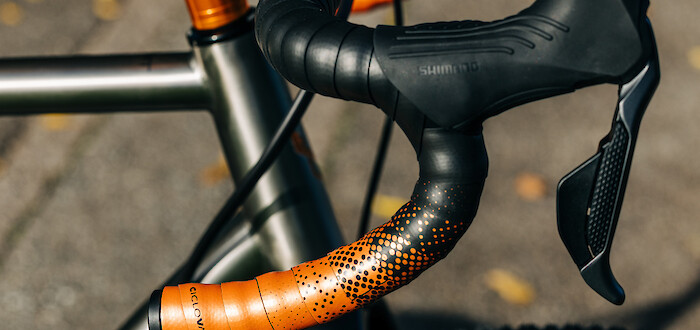What's the best bicycle frame material?


All the facts on bicycle frame materials
How often have you heard any of these phrases?
“Steel bicycles weigh a tonne.”
“Carbon breaks easily.”
“Titanium isn’t worth the money.”
“Aluminium bikes are cheap and crappy.”
Yes, it seems no matter what your bike is made of, people are going to have an opinion about it. (People are people, after all.) As a result, there are a lot of popular misconceptions floating around out there about bicycle frame materials. But how do you tell fact from fiction?
You need a guide, and that’s what we’re here for.
So before you make your next bike purchase, let’s get stuck into the facts on frames. Get ready for some myth-busting.
Note: we’re covering the most common frame materials here. This is not the spot for a deep dive on bamboo bikes, sorry.

Bike frame materials explained
First up, a note on metal definitions.
Although we tend to refer to a frame as ‘steel’, ‘aluminium’ or ‘titanium’, that frame’s material will actually be an alloy.
‘Alloy’ means the combination of two elements, with at least one of those being metallic. To this end, all metal frames are alloys as they all include other elements.
- Titanium frames are most commonly an alloy of titanium with added aluminium and vanadium.
- Aluminium (if you consider Bauxite to be the natural version of aluminium, and for the sake of this blog, we will) is usually mixed with silicon or magnesium. Aluminium bike frames tend to be alloys such as 7005 and 6061.
- Unlike titanium ore and aluminium, which are natural elements (e.g. you can pull them out of the earth), steel is a purely manufactured product. It’s created by combining iron with carbon, so it’s already an alloy even before we start adding things to it to create a frame. The most common steel bike frames are alloys such as chromoly or stainless steel, but sometimes are just purely high-tensile steel.
Now we’ve worked out exactly what we’re talking about, let’s take a look at each material and its best applications bicycle-wise.
(We're looking at carbon, too, of course. How could we not?)

Steel
- Pro: Strong, durable, shock-absorbing.
- Con: Can be heavy.
Steel has a long pedigree in bicycle manufacturing, beginning with the all-steel safety bicycle which was developed around the 1870s as an alternative to the cast-iron penny-farthing. (And it was indeed called the safety bicycle because you were far less likely to hurt yourself on it.)
The safety bike also replaced earlier wooden bicycle prototypes, which looked about as comfortable as straddling a fence. Which we guess you kind of were, in a way.
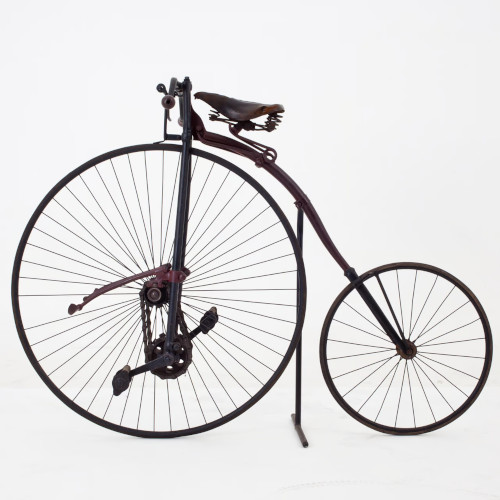
Steel is primarily known for its strength, so it's perfect for building something designed to take the weight of a person, and sometimes their luggage as well.
Strength isn’t steel’s only virtue, however; it also offers some elasticity – it will bend before it breaks – which, when made into a bike frame, dampens bumps and vibrations to give a smooth ride.
Steel’s durability and comfort are the major reasons why it continues to be a popular frame material 150 years later, especially for long-distance riding and gravel/adventure bikes. #steelisreal
Not all steel is created equal, however.
High-grade steel offers lightness, plushness and durability -- it's the material that every manufacturer overall is trying to emulate.
On the other end of the spectrum, cheap, high-tensile steel can be used to manufacture durable frames, but you pay a hefty toll in weight. Your bike will probably never break, but you’ll never want to lift it over a fence, either.

Good-quality chromoly steel is far lighter than its cheaper counterparts without compromising strength, and can be made stronger again. Many people have been surprised at how light a Genesis or Breezer actually is, and Pete’s custom-made road bike tips the scales at just over 7kgs (with pedals), which is pretty respectable for a bike with a steel frame and fork.
Another major advantage with steel is that it can easily be repaired. But we’ll address that in a bit.
Overall, a steel-framed bike can potentially last you a lifetime.
As long as you don’t live by the sea.

Aluminium
- Pro: Can be cheap, generally light.
- Con: Brittle, shorter lifespan, hard to repair.
Aluminium’s main claim to frame fame is its weight. In alloy form, it’s lighter than steel, and it can even be made to be lighter than a mid-level carbon frame.
The trade-off to this weight advantage is that aluminium isn’t as strong as other metal frames. Some manufacturers address this by making oversized tubing and increasing the wall thickness of the tubes (though, if the tubing is chunky enough, it can ironically end up being heavier than steel, which kinda defeats the point).

Another downside is that aluminium has a shorter lifespan than steel – the more it flexes, the more fatigued it gets.
Its brittleness also means that—unlike steel, carbon and titanium—once it starts to bend, it usually breaks, and a broken aluminium frame is difficult to repair. When the material is welded, it changes the metal’s structural properties, and unfortunately weakens the surrounding area. (This is why factories need to chemically or thermally reset the frame after it’s been built to realign the alloy’s grain.) When it comes to a post-production repair, if you fix one area, the bit immediately next to the weld is now far more likely to break – you’re essentially just moving the problem along the frame rather than solving it.
Because of this issue, most repairers won’t touch aluminium frames.
Just as a kicker, a bent aluminium frame also can’t be straightened reliably; it’ll usually crack during the process, or will develop a memory and return to its bent state fairly quickly afterwards.
(Yes, metal can have a memory. It’s Terminator all over again.)

Fortunately, aluminium is generally cheaper than other materials, so if you end up with a bent or broken frame that needs to be retired, at least you won’t be paying an arm and a leg for a replacement. And there will be plenty to choose from – there are so many aluminium frames on the market that some people think all bike frames are aluminium. Fools! (Just kidding.)
But don’t let people tell you that if a bike is aluminium, it automatically isn’t good quality. Hell, Ibis make aluminium models, and they’re pretty damned fussy.

Carbon
- Pro: Light, strong.
- Con: Costs more.
When you think ‘carbon frame’, you usually think ‘expensive’. And that’s correct – good-quality carbon tends to be pricier than steel or aluminium.
For the cost, however, you get a frame that’s light and resilient, perfect for situations where every gram counts.
The most interesting thing about carbon as a frame material, however, is that it can be put together in almost limitless ways. Unlike metal, which has to come from a foundry, carbon is a prefabricated material and can be made into pretty much any shape you can imagine. The fibres of the material can be loaded and arranged in different ways to achieve different objectives – strength at high-load areas, flexibility in others.
It means the builder has ultimate control over the ride quality, weight, design, stiffness, etc. (This can be good or bad, depending on who's building your bike.)

While carbon can be stronger than you’d think, you still need to be careful with it – it won’t necessarily survive a dent that a steel frame can absorb. If the worst does happen, though, carbon can be repaired (even if good carbon frame repair specialists can be hard to find, especially now).
Overall, custom carbon comes at a price, and with this material you tend to get what you pay for. We see a lot of cheap unbranded carbon frames that have been purchased online; they’re usually riddled with manufacturing errors and, in some cases, are downright dangerous.
Save your money and put it towards something from a reputable frame manufacturer.
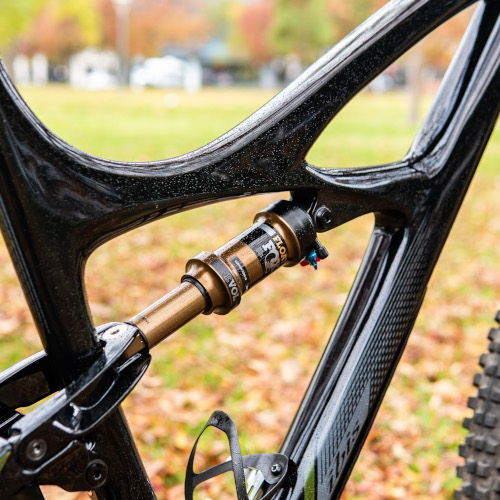
Titanium
- Pro: Light, strong.
- Con: Expensive.
For many riders, titanium is the holy grail of frame materials. It has a longer fatigue cycle than steel while simultaneously being lighter. Unsurprisingly, it’s also the most expensive frame material. (Until someone starts making rhodium bikes, that is.)
You can blame titanium’s high price point on two factors:
- the cost of the raw material
- the fact that titanium is harder to work with than other metals – the properties that make it durable are the same ones which make it hard to weld.

So why is titanium such a great material for bikes? Mainly because of its strength-to-weight ratio – you get a lot of bang for your buck, so to speak, with titanium having the same strength and durability properties as steel but without the same weight.
Like steel, titanium is excellent when it comes to shock absorption, leading to a more comfortable ride. It's also very resistant to impact, and, interestingly, tends to return to its original shape after a hit. (We weren’t kidding about metal having a memory.)
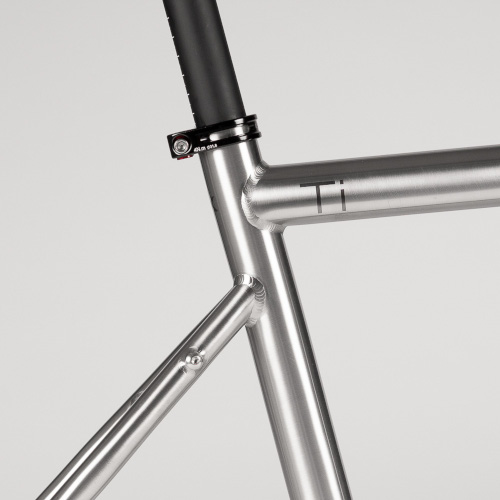
So now that you know the ins and outs of each frame material, let’s get a bit more specific as to what their best uses are bicycle-wise.
What’s the best bike frame material for commuting?
A metal frame makes the most sense for a commuting bike as it’s more likely to get knocked around, especially if you’re locking it up in public or in a shared area.
However, budget is going to be the deciding factor here, especially if you haven’t got much to spend.
A cheap steel frame is heavy.
A cheap aluminium frame rides like a tank.
A cheap titanium frame… well, a good cheap titanium frame doesn't exist. We’ve seen several budget internet Ti frames and they’re full of manufacturing flaws -- sometimes to the point of being impossible to assemble. Our guess – and it’s only our guess, don't sue us – is that these frames get rejected by the actual bike brand and so the factory sells them off to the unsuspecting public.
A cheap carbon frame potentially has a mixture of all of the above problems. Hurray!
As with any kind of manufacturing, it will always come down to the company and how they’ve built the frame.
At the very least, look for something that has mounting points on it as there’s no point buying a commuter and then discovering that you can’t put mud guards on it or your panniers won’t fit. Commuting with a backpack sucks, especially in summer.

What’s the best bike frame material for touring?
Again, metal makes the most sense here. But which metal?
For once, the answer is easy: steel.
Is it because of its smooth, bump-absorbing qualities? Partially.
Is it because of its durability? Also partially.
Mostly, however, it’s because steel can be repaired, and you don’t need a bike shop or frame repairer to do it.
Imagine that you’re cycling across the plains of Uzbekistan. All you’re thinking about is where you can find your next carbohydrate fix when – disaster! You’ve crashed and broken your frame. Wait… is that a farm up ahead? It is! Do they have a welder to fix their farming equipment? They do! The day is saved - your bike can be patched up, and you can get back on the road.
If you’re riding aluminium, titanium or carbon, however, you’ll want to hope that the farm has a bike you can buy instead as your current one is now toast.
So for touring, especially if you’re going into remote areas, go steel all the way.

What’s the best bike frame material for road racing?
Carbon is always going to be the most popular material for road racing.
It’s the lightest of all frame materials and can be made into any shape you want.
It's also often aesthetics-focused (which, as anyone who’s been involved in the roadie scene knows, is wallet-chokingly high on the agenda).

In addition, carbon can be made into a very stiff frame, which is exactly what racing needs. The trade-off is that if it’s badly made and too rigid, it’ll be a teeth-rattling, bone-jarring ride.
Whether you need to go carbon or not also will partly depend on what kind of racing you’re doing.
If you’re racing long, flat stages (not time trials), frame material isn’t as relevant as you’d think.
In hills stages, though, the differences start to show themselves, especially if you’ve got a heavy or harsh frame. This discrepancy can be what’s standing between you and a podium finish/PB.

What’s the best bike frame material for gravel riding?
The best frame material for a gravel bike depends on how you like to travel.
If you want to keep things light, aim for titanium.
For those whose budgets don’t stretch quite that far, steel is always a reliable choice for smoothness and durability.
There are also a lot of carbon gravel bikes hitting the market, which offer lightness but at a more affordable pricepoint than titanium. The problem with carbon bikes, however, is when you start strapping bags to them. Bags move around -- even if they're well-secured -- as you ride. The combination of moving straps and the inevitable dirt that comes from riding outdoors acts as an abrasive on your frame. We see a lot of damage done this way, so be mindful of it if you're considering this material.
Many major brands are also now offering aluminium gravel bikes as the popularity of this discipline continues to grow, but most of their offerings have been less than impressive, unfortunately, so it's hard to recommend them at this point.

What’s the best bike frame material for mountain biking?
For weight, ride comfort and durability, high-grade steel would be a lovely choice.
There are limitations to lightweight steel, however. Pete’s custom mountain bike -- which he had made through a frame builder as an experiment -- is a good example of this. In his exact words, "It flexed like a bastard and broke easily.”

As it can be tricky to find a high-grade steel MTB rig, though, most of your options will be either aluminium or carbon.
Like road riding, if you’re racing (and have the budget), carbon obviously gives you a weight advantage against your competitors. Some people worry about taking carbon bikes off-road into areas with rocks and roots and pointy things, but this concern is generally unfounded -- as noted before, a carbon manufacturer can play with the material to give strength where it’s needed, such as common impact points.
And, of course, as we’ve discussed previously, carbon can be patched up if it’s damaged, unlike an aluminium frame.

What’s the best bike frame material for heavier riders?
Primarily, this will be dictated by the manufacturer's weight limit, and it can vary greatly from brand to brand and frame to frame so you'll always want to check the recommended specs before you buy.
Some people also assume that bigger riders are better off with burlier metal frames, but that's not necessarily the case. Because carbon can be made in any form, it has the potential to suit heavier riders the best. There's a limit to what you can do with metal tubes -- carbon has no such limit, and thus can be shaped and manufactured to deal more easily with heavier loads and forces. Don't discount it purely on its reputation as a physically light material.
With that said, if you’re looking at lightweight frames and components from boutique companies such as AX Lightness, you will want to make sure you’re well below their maximum weight limit. Think of it like torque ratings on carbon components: you want to make sure you don’t hit that upper number.
(Side note: this is often why people end up cracking carbon bits when tightening bolts, even if using a torque wrench – the max rating is a MAX recommendation, not a mandate.)

What’s the best bike frame material for coastal/snowy/salty environments?
For many bike riders, the environment you live in isn’t usually something you have to consider when choosing a bike frame. This isn't the case, though, if you live near the coast or somewhere snowy.
If you’re living that beach life or in an otherwise salty environment, you’ll want a titanium frame. In addition to its other glorious qualities, titanium is an inert metal: it does not rust. Steel and aluminium, in the same environment, will corrode into nothing but dust and shattered dreams.

But what about if you live in an area that has snow or ice? Maybe your local roads get salted? Then, again, you’ll want a titanium frame, as the same principle applies.
Remember: where traditional metals suffer badly, titanium will survive.

Finally, we have to add this one as it’s a question we are frequently asked.
How can I tell what my bicycle's frame is made of?
We see a lot of people tap-tap-tapping at frames in the shop to try to work out what the material is. (Or perhaps they just like the sound, who knows.)
Unsurprisingly, pinging a frame with your fingernail isn’t the best way to tell what it actually is.

Let’s make it easier with our patented-but-not-really BMCR Frame Material Elimination Method.
- Firstly, get a magnet and see if it sticks to the frame. If it sticks, that frame is steel.
- If a magnet doesn’t stick, check out the frame’s welds.
- “...Wait, this frame doesn’t have welds.” Then congratulations, it’s carbon.
- If your frame does have welds, inspect them carefully. Are they big and chunky? Then you’re probably looking at an aluminium frame.
- If the welds are small and neat instead, then it’s most likely titanium.
Ta-da!
Caveat: some manufacturers have been known to grind back the welds on their aluminium frames to make them nice and smooth. While this may be an aesthetic improvement, it comes at a cost: the frame will then usually break, as the material that holds the tubes together (i.e., the weld) has been removed or reduced. There's one brand who's notorious for doing this, which is why they're referred to in the trade as Crack 'n' Fail. (Sorry.)
Here, we made you a flow chart:
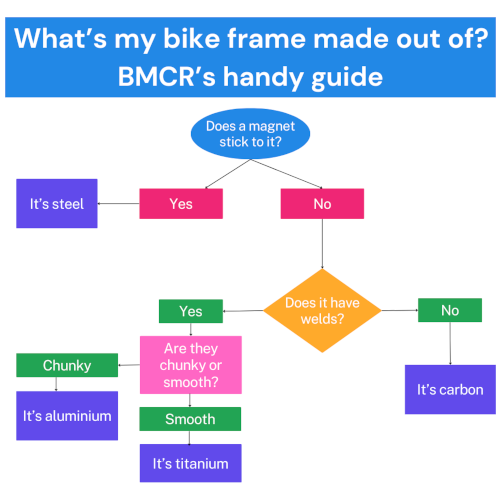
A final note: magnesium
You might be wondering why this post didn't cover magnesium frames. Well, there's a very good reason.
They break.
Magnesium is not only soft but also corrodes easily and needs surface treatments to stop it oxidising. It's light but difficult to weld (try Googling 'magnesium fire'), and many designs require additional reinforcing plates to hold the frame together.
Although some bike companies are working with this material, it's not something that we'd recommend at this point in time.

Now you know the ins and outs of frame material
Go steel for touring and longevity.
Go titanium if you live in wild environments or want plush lightness and durability.
Go carbon if speed and style are your thing.
Go aluminium if you want to keep it wallet-friendly.
Overall, regardless of material choice, everything comes down to the maker of the bike. There are beautifully made bikes and crappy deathtraps made out of the same material – the manufacturing process and design is what makes the difference.
Do your research, and listen to your bike mechanic, not some rando on a forum.
Like the look of one of our bikes, or thinking of a custom build? Drop us a line.
Just because there's a steel mining joke in it.

